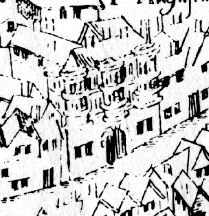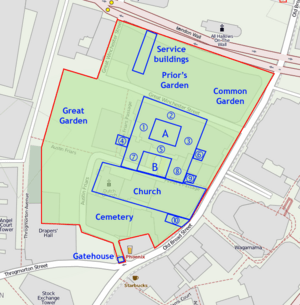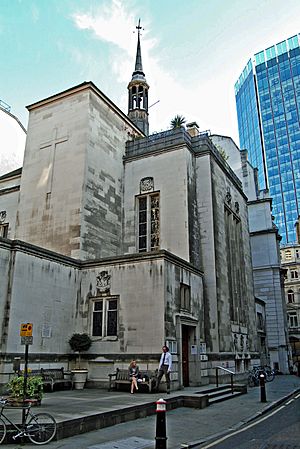Austin Friars, London facts for kids

Plan of Austin Friars, 1550s
|
|
| Monastery information | |
|---|---|
| Order | Augustinian |
| Established | 1260s? |
| Disestablished | November 1538 |
| Dedicated to | St Augustine |
| Diocese | London |
| People | |
| Founder(s) | Humphrey de Bohun, 2nd Earl of Hereford |
| Site | |
| Location | City of London, England |
| Coordinates | 51°30′56″N 0°05′08″W / 51.51557°N 0.085579°W |
| Grid reference | TQ 32912 81334 |
| Visible remains | Dutch Church, Austin Friars |
| Public access | Yes (Dutch Church only) |
Austin Friars, London was a special kind of monastery called an Augustinian friary. It was located in the City of London and was built around the 1260s. A friary is a place where friars, who are like monks but live among people, pray and work. This friary was closed down in November 1538 during a time called the Dissolution of the Monasteries.
The friary covered a large area, about 5.5 acres, which is like 4 football fields. It was near where the Bank of England is today. Around 60 friars lived there. At the center was a church, and behind it were buildings for the friars to live, eat, and study. There were also big gardens where they grew vegetables, fruit, and plants for medicine.
Some parts of the friary land were rented out for houses. Famous people like Erasmus and Thomas Cromwell lived in these houses. Cromwell was a very important helper to King Henry VIII. As Cromwell became more powerful, he bought more land from the friary to build a huge house. But when he lost the King's favor, his house was taken by the Crown. Later, this house became the Drapers' Hall. The main part of the friary church became the Dutch Church.
Contents
History of Austin Friars
Augustinian friars first came to England around 1249. The Austin Friars in London was started in the 1260s. A man named Humphrey de Bohun, 2nd Earl of Hereford founded it after returning from the Seventh Crusade. It was built in the north of the City of London. To make space, an old church called St Olave Broad Street was taken down. Another church, St Peter the Poor, became part of the friary church.
By the late 1300s, the friary had grown to 5.5 acres. It had about 60 friars for a long time, though this number changed. Most friars were English, often from areas near London. Rich and important people liked Austin Friars. They used it for worship and as a burial place. The friary made good money from these connections. The church was rebuilt in 1354 to be much grander. They even built a new steeple after a storm destroyed the old one in 1362. By the 1500s, the friary earned a lot of money from rents and gifts.
The friary was also an important place for learning about religion. It had a studium generale, which was like a university. Students came here before going to places like Oxford or Cambridge. It had a school and a library. Not just English people, but also foreigners living in London, especially Italians and Germans, studied there. Sometimes, friars from other countries would study at Austin Friars and then stay to help their countrymen in London.
During the Peasants' Revolt in 1381, some people hiding in the friary were taken out and killed by an angry crowd. However, the friars themselves were not harmed. Later, in 1386, a sermon given nearby almost caused a mob to destroy the friary. Luckily, the local sheriff stopped them.
Many important people were buried at the friary. This included its founder, Humphrey de Bohun. Other burials included Hubert de Burgh, 1st Earl of Kent, Edward (the son of the Black Prince), and many knights who died in the Battle of Barnet in 1471.
Buildings of the Friary
The friary was built over many years as money and land became available. The church and other buildings might not have been finished until after 1350. Like other friaries in cities, it had a tall wall around it for privacy. This wall was made of stone or brick. You could enter the friary through at least three gates. The main gate was on Throgmorton Street and led to the church.
The friary church was in the middle of the complex. The King gave the friary six oak trees in 1277, possibly for the roof. Gifts in the 1300s show that building continued into the 1370s. The main part of the church, called the nave, survived until it was destroyed in The Blitz in 1940. We know a lot about its original look and size because it was studied before the war.
The church was built with Kentish Ragstone and Reigate stone. It had a nave with three aisles and a choir with two aisles. The nave was about 149 feet long and 83 feet wide inside. The main entrance was at the western end. The altar, likely dedicated to St Augustine, was at the eastern end. The choir was about 96 feet long and 57 feet wide. The old church of St Peter the Poor became the south aisle of the friary church. There were also several smaller chapels dedicated to different saints.
A cemetery was located south of the church. Not much is known about it. A preaching pulpit and a cross were west of the churchyard.
The friary had two cloisters, which are open courtyards surrounded by covered walkways. The one to the south was the main cloister. Records from the 1500s help us know what buildings were around them. The main cloister had a main and a smaller chapter house (meeting room). It was surrounded by dormitories for guests and friars. Near the guest hall was a porter's lodge, which controlled who came in. A refectory (dining hall) separated the north and south cloisters. The north cloister had a library, an infirmary (hospital), and kitchens. The prior's house was next to the south cloister and might have had its own entrance to the church.
There were other buildings too, but less is known about them. There would have been service buildings to help run the friary. The studium generale (school) would have had its own building. The friary was also the only one in London known to have its own prison. The friary also had large gardens, mostly at the northern end. The biggest was the Great Garden, which was about 388 feet long. These gardens were used to grow vegetables, medicinal herbs, and fruit trees.
Thomas Cromwell's Big House

Monasteries in London often rented out land to people who were not monks. Austin Friars did this too. Several houses were built on the western side of the friary land. The friary also owned properties just outside its walls, including two inns. Important people rented the larger houses. In the early 1500s, these renters included Thomas Cromwell, a rich Italian merchant, the Holy Roman Emperor's ambassador, the French ambassador, and Erasmus. These properties brought the friary a good amount of money each year.
Thomas Cromwell's house was very important. It played a role in his own story and the friary's future. His first house was west of the churchyard. It was a large house with fourteen rooms and a garden. His wife was living there by 1525, and he might have been there even earlier.
By 1532, Cromwell was a key figure in King Henry VIII's court. He needed a bigger house to match his high position. He bought more land at Austin Friars for £550, which was a huge amount of money back then. He ended up with one of the biggest private properties in London, covering 2 acres, including a large garden. From 1535 to 1539, Cromwell spent over £1,000 building his grand house. He hired at least 98 workers. The house was meant to be his family home, an office, and a palace to entertain important guests, even the King.
We know a lot about the house's design because it was surveyed later. It had two main floors, with a third floor and attics at the front facing the street. It was mostly built of brick with thick walls. An old map from the 1550s shows the impressive front of the house with three bay windows above a large gate. The building had over fifty rooms around three courtyards. There were several halls on the first floor, including one with fancy tapestries. Cromwell's family lived on the first floor, and servants lived on the second floor and in the attics. The kitchens and service rooms were on the ground floor. The house also had its own chapel. Cromwell planned to build stables, a tennis court, and a bowling alley in the garden.
When Cromwell lost power in June 1540, his mansion was taken by the King. He was executed the next month. For three years, the King owned the house. Then, it was sold to the Drapers' Company. Part of it became their new company hall. The rest was rented out. The garden was used by Company members and others for a fee.
The Friary and the Reformation
The later story of the friary is connected to the English Reformation. This was a time when England changed its main religion. In 1526, a scholar and Augustinian monk named Doctor Robert Barnes was punished for having different religious ideas. He was sent to Austin Friars in London. Even though he was supposed to be under house arrest, he was quite free. He could meet people and even buy and sell English New Testaments, which were banned at the time.
Thomas Cromwell, who lived next door, was a big supporter of the English Reformation. He found the Prior (leader) of Austin Friars, George Brown, to be helpful to his cause. Prior Brown preached sermons that supported King Henry VIII's divorce and new marriage. Cromwell later rewarded Brown by making him a commissioner. Brown's job was to visit all the monasteries in England to check their religious practices and wealth before they were closed down.
Cromwell wanted to close the monasteries because he thought many monks and friars were not following their rules. In 1534, some friars at Austin Friars reported that services were being neglected, and friars were drinking and eating alone.
The friary was officially closed in November 1538 by Cromwell's orders. Its income went to the Crown. Sir William Paulet, 1st Marquess of Winchester bought the friary buildings and built a house there. The City of London tried to buy the friary church from the King twice but was refused. In July 1550, a community of "Germans and other strangers" from London was allowed to use the church's nave. It became the first official nonconformist chapel in England. Its minister was Jan Łaski from Poland. His congregation was from Frisia, which is now part of Germany and the Netherlands. This is why the church is now called the Dutch Church, and Dutch is still used for services there.
The rest of the church was used as a storage place for corn, coal, and wine. The old monuments were sold, and the lead was taken from the roof. The choir, tower, and transepts were pulled down in 1600. In 1862, a fire destroyed the rest of the church. It was rebuilt but then destroyed again in the Blitz during World War II. It was rebuilt once more between 1950 and 1956.
Today
Today, the old friary site is split by a road called Austin Friars. Most of the area is now covered by office buildings. However, the Drapers' Hall and the Dutch Church still stand there. Both buildings are replacements for the older ones that were destroyed.
In literature
Hilary Mantel's novels Wolf Hall and Bring Up the Bodies tell a fictional story about Thomas Cromwell. Many scenes in these books take place at his home in Austin Friars.
An early writer named Sarah Blackborow lived in Austin's parish in London.
In Chapter 29 of Charles Dickens's novel Martin Chuzzlewit, a character named Tom Pinch is called to Austin Friars for a job offer.
Images for kids






